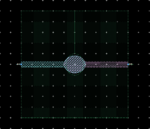saeedbayanlou
Newbie level 6
- Joined
- Oct 23, 2011
- Messages
- 11
- Helped
- 2
- Reputation
- 4
- Reaction score
- 2
- Trophy points
- 1,283
- Location
- Tehran, Iran, Iran
- Activity points
- 1,354
Follow along with the video below to see how to install our site as a web app on your home screen.
Note: This feature may not be available in some browsers.


You got 3 metal layers and no GND.
I would think that the center layer is the ground in this circuit.
If we want to create the regular layout, draw the layout as RealAEL has described. But obviously, there are no circuit/schematic models to simulate this type of layout, and we need to use EM analysis.
For efficient EM analysis with Momentum, the "simulation layout" would be created differently than the "regular" layout: In Momentum, you can map the ground as a "slot" layer instead of a "strip" layer. This with mesh the slot instead of the metals, and use a "magnetic current" approach for more efficient simulation. To use this slot layer simulation, you need to draw the layout where there is NO metal. In your case, you draw the hole instead of the metal.
Top and bottom layer: map as strip layer, draw condutors
Middle ground layer: map as slot layer, draw hole
What is the exact theory behind of this idea ??
Thank you all
I have attached the layout drawn by myself, but didnt get the expected results:sad: ANY SUGGESTION?
Best regards
View attachment 77886
Ok.It's an UWB 30 degree phase shifter.
